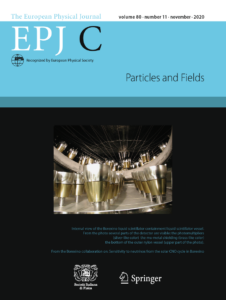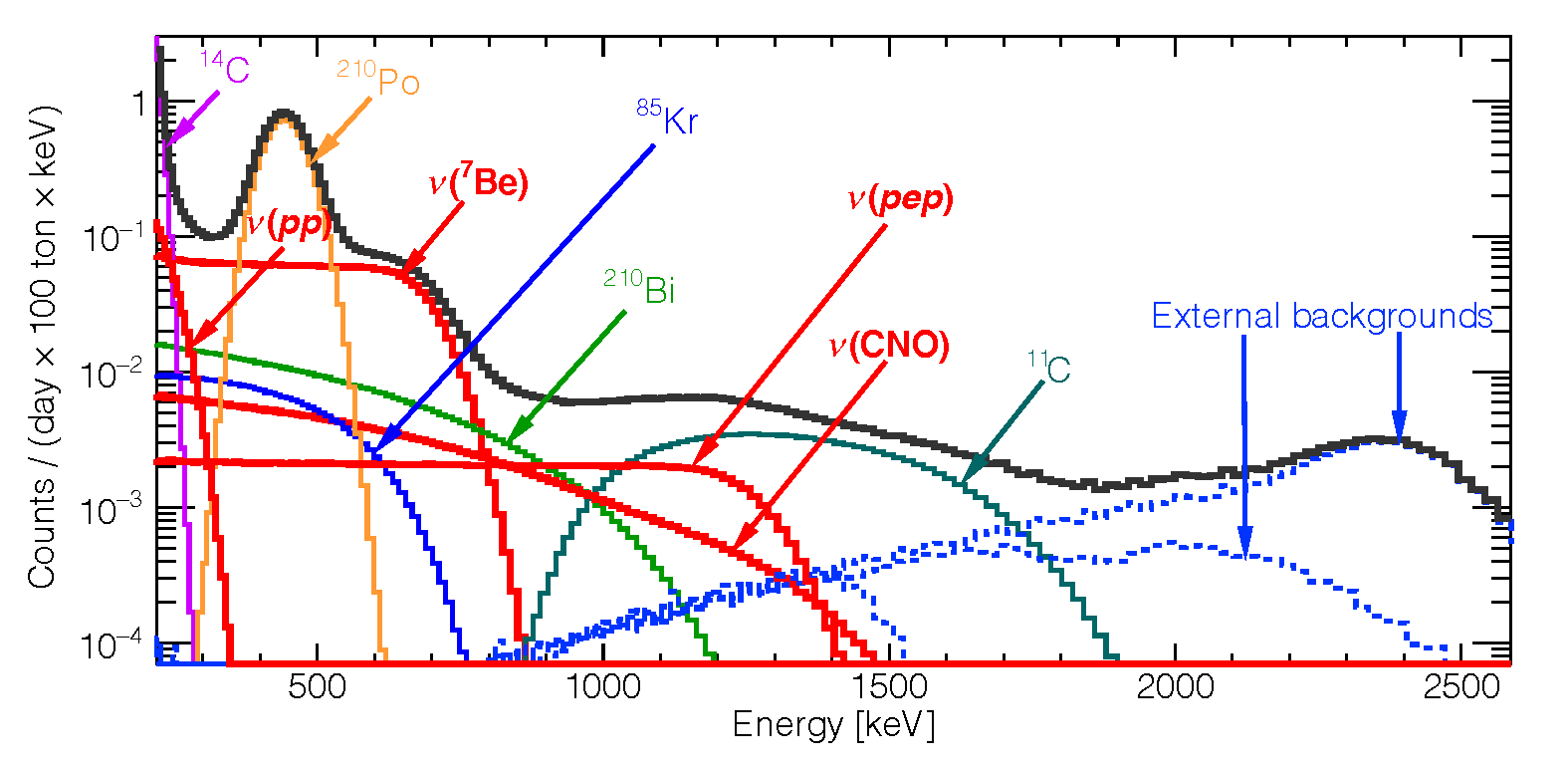Table of Contents Show
Sensitivity to neutrinos from the solar CNO cycle in Borexino
Eur. Phys. J. C 80, 1091 (2020)
[doi:10.1140/epjc/s10052-020-08534-2]
published 26 November 2020 (cover story)
This paper have been been highlighted on EPJ C Highlight, Springer Research News and Europhysics News (“Detecting solar neutrinos with the Borexino experiment”).
Data availability
The datasets generated during the current study are freely available: see below (scroll down). Additional information is available from the Borexino Collaboration spokesperson (spokesperson-borex@lngs.infn.it) upon reasonable request.
Abstract
Neutrinos emitted in the carbon, nitrogen, oxygen (CNO) fusion cycle in the Sun are a sub-dominant, yet crucial component of solar neutrinos whose flux has not been measured yet. The Borexino experiment at the Laboratori Nazionali del Gran Sasso (Italy) has a unique opportunity to detect them directly thanks to the detector’s radiopurity and the precise understanding of the detector backgrounds. We discuss the sensitivity of Borexino to CNO neutrinos, which is based on the strategies we adopted to constrain the rates of the two most relevant background sources, pep neutrinos from the solar pp-chain and 210Bi beta decays originating in the intrinsic contamination of the liquid scintillator with 210Pb. Assuming the CNO flux predicted by the high-metallicity Standard Solar Model and an exposure of 1000 days x 71.3 t, Borexino has a median sensitivity to CNO neutrino higher than 3 ![]() . With the same hypothesis the expected experimental uncertainty on the CNO neutrino flux is 23%, provided the uncertainty on the independent estimate of the 210Bi interaction rate is 1.5 cpd/100 ton. Finally, we evaluated the expected uncertainty of the C and N abundances and the expected discrimination significance between the high and low metallicity Standard Solar Models (HZ and LZ) with future more precise measurement of the CNO solar neutrino flux.
. With the same hypothesis the expected experimental uncertainty on the CNO neutrino flux is 23%, provided the uncertainty on the independent estimate of the 210Bi interaction rate is 1.5 cpd/100 ton. Finally, we evaluated the expected uncertainty of the C and N abundances and the expected discrimination significance between the high and low metallicity Standard Solar Models (HZ and LZ) with future more precise measurement of the CNO solar neutrino flux.
Open Data
Neutrinos emitted in the carbon, nitrogen, oxygen (CNO) fusion cycle in the Sun are a sub-dominant, yet crucial component of solar neutrinos whose flux was not measured until late 2020 when the Borexino experiment published it on Nature. The Borexino experiment at the Laboratori Nazionali del Gran Sasso (Italy) has a unique opportunity to detect them directly thanks to the detector’s radiopurity and the precise understanding of the detector backgrounds. In our 2020 EPJ-C paper, we discuss the sensitivity of Borexino to CNO neutrinos, which is based on the strategies we adopted to constrain the rates of the two most relevant background sources, pep neutrinos from the solar pp-chain and ![]() Bi beta decays originating in the intrinsic contamination of the liquid scintillator with
Bi beta decays originating in the intrinsic contamination of the liquid scintillator with ![]() Pb.
Pb.
Assuming the CNO flux predicted by the high-metallicity Standard Solar Model and an exposure of 1000 days x 71.3 t, Borexino has a median sensitivity to CNO neutrino higher than 3![]() . With the same hypothesis the expected experimental uncertainty on the CNO neutrino flux is 23%, provided the uncertainty on the independent estimate of the
. With the same hypothesis the expected experimental uncertainty on the CNO neutrino flux is 23%, provided the uncertainty on the independent estimate of the ![]() Bi interaction rate is 1.5 cpd/100 ton. Finally, we evaluated the expected uncertainty of the C and N abundances and the expected discrimination significance between the high and low metallicity Standard Solar Models (HZ and LZ) with future more precise measurement of the CNO solar neutrino flux.
Bi interaction rate is 1.5 cpd/100 ton. Finally, we evaluated the expected uncertainty of the C and N abundances and the expected discrimination significance between the high and low metallicity Standard Solar Models (HZ and LZ) with future more precise measurement of the CNO solar neutrino flux.
In this plot (Fig. 3 of our paper) we show the expected event energy distribution of an arbitrary exposure without statistical fluctuations and after the fiducial volume cut. The solar neutrino components are highlighted with bold red lines. The spectra of the relevant background contributions are scaled to existing measurements. The contribution of the decay of the ![]() C isotope reported in the plot is reduced by the application of the three fold coincidence (TFC) procedure previously described in G. Bellini et al. (2014) and M. Agostini (2020).
C isotope reported in the plot is reduced by the application of the three fold coincidence (TFC) procedure previously described in G. Bellini et al. (2014) and M. Agostini (2020).
Here below you find the bin-infos (energy_min-bin, energy-max-bin, bin content, bin error) of each PDF for both the neutrino and background signals.
 (pp)
(pp) (
( Be)
Be) (pep)
(pep) (CNO)
(CNO) C
C Po
Po Kr
Kr Bi
Bi C
C- external background:
 Tl
Tl - external background:
 Bi
Bi - external background:
 K
K
The bin infos (energy_min-bin, energy-max-bin, bin content, bin error) of the total expected event energy distribution is available here.

